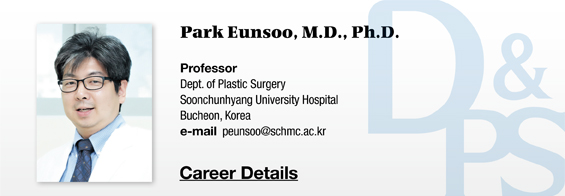▶ Previous Artlcle : #13-2. Biologically Derived Collagen: Elastin Dermal Substitute
Growth factors are named after their cellular functions or the cells they are produced from. As research continues and new functions are discovered or old functions are disproved, discrepancy exists between some growth factor names and their functions, causing confusion. For example, FGF (Fibroblast Growth Factor) is a potent angiogenesis factor unlike its name and TGF (Transforming Growth Factor) carries an important function in preventing malignant transformation and does not transform cells as suggested in the name. Additionally, the nomenclature of growth factors can be influenced by the specialty of the investigator who discovered them. A biochemist may prefer the term ‘growth factor’, whereas a immunologist would call the same substance ‘interleukin’ and a hematologist would name it ‘colony stimulating factor’.
[Advertisement] ATLAS(Long pulse 532nm & 940nm dual wavelength) – Manufacturer: MEDRO(www.medro.net)
Various cellular experiments conducted over the last three decades have proven that growth factors, even in very small amounts, effectively control cell proliferation, extracellular matrix production and chemotaxis. Animal studies have also shown that growth factors promote wound healing. This led to biosynthesis of large amounts of growth factors in laboratories, which have yielded various products with wound healing effect. Early products were developed for treatment of chronic wounds such as diabetic foot and pressure sores but its application is rapidly evolving to minimizing scar through dermal regeneration and accelerated wound healing as well as combination with negative pressure therapy, etc. Among these growth factors, this article will discuss epidermal growth factors (EGF).
In 1962, EGF was first isolated as a potent stimulator of cell growth of epidermal cells by Stanley Cohen who discovered EGF by chance while isolating nerve growth factors from mourine submaxillary gland. Cohen proved that injection of crude submaxillary gland preparation in a mouse led to precocious eyelid opening and coined the terminology ‘epidermal growth factor.’ He was awarded the Nobel Prize in Physiology and Medicine in 1986, in recognition of his discovery of EGF. EGF is a protein consisting of 53 amino acids with the molecular weight of about 6045 dalton. Human EGF has the molecular structure of three disulfide bonds. EGF is produced by the proteinase action of precursor protein consisting of 1217 amino acids. EGF precursor is known to play a crucial role in cellular interaction. EGF binds to epidermal growth factor receptor (EGFR) of 170kDa to carry out various intracellular functions by activating Shc·Grb2·Ras·Raf·MAPK or PI3K·Akt pathway. EGFR closely resembles the cancer gene erbB in its sequence.
EGFR is also a receptor that recognizes EGF on the cell surface and promotes cell growth and differentiation. As cancer cells are generated by uncontrolled differentiation, excessive amounts of EGFR exist on the surface of cancer cells. Therefore, cancer patients with higher level of EGFR require more aggressive therapy. This receptor is closely related to the cancer of the lung, colon, pancreas and breast. This receptor is not used as a parameter in diagnosis or outcome evaluation of cancer but response to a certain medication and prognosis can be evaluated through EGFR mutation analysis or receptor density test.
Recently, EGFR target therapies such as geftinib or erlotinib were shown to lengthen the survival by 2-3 fold in lung cancer patients with EGFR mutation compared to those without EGFR mutation. This discovery opened up a new approach to cancer treatment. EGFR mutation is reported to be more common in non-smoking Asian female patients.
EGF is produced in platelets and is not detected in normal plasma. However, due to its rich concentration in platelets, during blood coagulation, in other words, early phase of wound healing, the plasma EGF concentration drastically increases to reach sufficient levels for cell differentiation and migration. Moreover, the local action of EGF freed from platelets during the early phase of wound healing is known to promote growth of epidermal tissues. Besides platelets, EGF is synthesized in the kidney, submaxillary gland, lacrymal gland, pancreas, small intestines, pituitary gland, and brain. It is found in the blood, urine, saliva, tears, cerebrospinal fluid and pancreatic juice.
-To be continued-
▶ Next Artlcle : #14-2. Understanding and Application of Epidermal Growth Factors





















